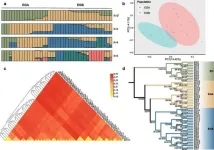(Press-News.org) Sjögren’s disease is a systemic autoimmune disorder that often causes sicca symptoms – or dryness of the eyes and mouth, alongside many other complications such as fatigue, pain, and neurological manifestations. There are treatments that help with symptoms, but none that address the underlying disease processes.3 One key issue in developing new treatments is that Sjögren’s can differ from person to person – and that makes it hard to measure and compare outcomes in a clinical trial.
NECESSITY is an interventional trial looking at new clinical endpoints in Sjögren’s disease. This is an international project involving eight European countries, and coordinated by Professor Xavier Mariette. The aim is to identify sensitive endpoints that could be used in clinical trials to assess the efficacy of new medicines. In addition, the project hopes to find biological markers that could be used to identify specific subgroups of people with different disease types.3 Unusually, the project has gathered a consortium of 25 partners across academia and industry – including representatives from patient associations. This is a challenging initiative, but one which could add value and highlight patients’ unique experience and expertise around Sjögren’s and its numerous unmet needs. To assess the merits of working with patient advisory groups in this way, a survey was sent to each of the other partners. The intention was to collect a scientific point of view, as well as to identify obstacles and areas for improvement.
The main challenges identified included differences in perspectives and perceptions of Sjögren’s disease, as well as the need to go beyond strictly scientific considerations in order to include patient opinions and implement their ideas. Another concern was to ensure that patients find their place within the consortium amongst scientists, and about the time sometimes needed to explain technical aspects to ensure effective collaboration. Addressing these challenges will be important for future projects.
But when looking at the benefits of working with patient partners, there were some noteworthy findings. For example, a majority of respondents favoured working with patients to validate unmet needs – especially those around symptoms and care expectations. Some people also expressed the view that patient partners provide moral support, boost motivation, and retain empathy within the consortium. Over 95% of respondents stated they would be willing to seek out patient partners in the future, and view them as genuine research partners.
Overall, the NECESSITY consortium appears to have been a success, and could provide the basis for a collaborative model to address clinical research in the future, helping to answer questions from the perspective of both the patient and the medical community.
Source
Bouillot C, Piatrova A. Myths vs Realities: An honest feedback from the scientific community on collaboration with patients partners in the NECESSITY research project. Presented at EULAR 2024; OP0286-PARE.
Ann Rheum Dis 2024; DOI: 10.1136/annrheumdis-2024-eular.2931.
References
1. Patient Research Partners (PRP). https://www.eular.org/pare-patient-research-partners
2. de Wit MPT, et al. European League Against Rheumatism recommendations for the inclusion of patient representatives in scientific projects. Ann Rheum Dis 2011;70(5):722–26.
3. NECESSITY Project. https://www.necessity-h2020.eu/#necessity-project
About EULAR
EULAR is the European umbrella organisation representing scientific societies, health professional associations and organisations for people with rheumatic and musculoskeletal diseases (RMDs). EULAR aims to reduce the impact of RMDs on individuals and society, as well as improve RMD treatments, prevention, and rehabilitation. To this end, EULAR fosters excellence in rheumatology education and research, promotes the translation of research advances into daily care, and advocates for the recognition of the needs of those living with RMDs by EU institutions.
Contact
EULAR Communications, communications@eular.org
Notes to Editors
EULAR Recommendations
EULAR School of Rheumatology
EULAR Press Releases
END
Are patient partners a necessity in research?
Honest feedback from the scientific community
2024-06-14
ELSE PRESS RELEASES FROM THIS DATE:
Encouraging cooperation in inflammatory arthritis
2024-06-14
Inflammatory arthritis describes a group of diseases caused by an overactive immune system. The different types of inflammatory arthritis include rheumatoid arthritis, psoriatic arthritis, juvenile idiopathic arthritis, and ankylosing spondylitis. The most common symptoms are joint pain and stiffness. Pain is the predominant symptom in the majority of people with inflammatory arthritis, which contributes to the global burden of rheumatic and musculoskeletal conditions.1 Knowledgeable support can reduce ...
Protection against disease and treatment toxicity
2024-06-14
Autologous hematopoietic stem cell transplantation (aHSCT) for SSc has been proven the most effective treatment strategy with regard to overall and event free survival in selected patients.2 But a key limitation is its toxicity, and new treatment options are needed. Two abstracts presented at the 2024 EULAR congress in Vienna focused on novel approaches.
Jörg Henes presented on behalf of the AST MOMA investigators. This prospective, open-label, study evaluated the feasibility of aHSCT in patients with impaired lung or heart function, and also ...
Does BMO induced by mechanical stress progress to structural lesions?
2024-06-14
BMO in the sacroiliac joint on MRI is present in up to 84% of people with non-radiographic axSpA – but it is also often seen in a non-inflammatory setting, such as in women after childbirth.1,2 As back pain is common after childbirth, differential diagnosis with axSpA is an important issue in clinical practice.1 In axSpA, active inflammatory lesions are likely to progress to structural lesions over time – particularly fat lesions and erosions. But it is not known whether the same is true for BMO induced by mechanical stress. In June 2024, EULAR – The European Alliance of Associations for Rheumatology – held its annual congress ...
Is fish intake linked to JIA?
2024-06-14
In 2019, a Swedish prospective birth cohort study of over 15,000 children showed that consuming fish at least once a week during pregnancy and during the first year of life was associated with up to a 5-fold increased risk of JIA, compared to those with fish consumption less than once a week. This increased risk was primarily attributed to elevated exposure to heavy metals.1 Now, new research shared at the 2024 congress of EULAR – The European Alliance of Associations for Rheumatology – is investigating ...
Unpicking the complexity of systemic sclerosis
2024-06-14
SSc is a connective tissue disease with variable clinical presentation. It may affect the skin, blood vessels, heart, lungs, kidneys, gastrointestinal tract, and musculoskeletal system – and this complexity and diversity makes it challenging to treat.2 This clinical heterogeneity in SSc may be partially explained by SSc-specific antibodies, but a better understanding of additional risk factors and patient stratification is still needed. Three abstracts shared at the 2024 EULAR congress present a selection of new clinical research to enrich knowledge ...
Group tests novel therapeutic strategy to minimize progression of Duchenne muscular dystrophy
2024-06-14
In an animal model of Duchenne muscular dystrophy, Brazilian researchers tested a therapy that combines photobiomodulation using laser light or light-emitting diodes (LEDs) with idebenone, an antioxidant compound investigated for application in neurodegenerative diseases.
As reported in an article published in the journal PLOS ONE, the strategy prevented muscle degeneration and improved regenerative capacity in the muscle fibers affected by the disease.
Duchenne muscular dystrophy is the most common and most severe form of childhood muscular dystrophy and most often ...
NMDP and CIBMTR share new, promising stem cell transplantation trial data using mismatched, unrelated donors at the 2024 EHA Congress
2024-06-14
MINNEAPOLIS, June 14, 2024 — NMDPSM, a global nonprofit leader in cell therapy, and the CIBMTR® (Center for International Blood and Marrow Transplant Research®) announced interim results from the ACCESS trial as an oral abstract during the European Hematology Association (EHA) Annual Meeting in Madrid, Spain. The study demonstrated that adults with hematologic malignancies who received peripheral blood stem cell (PBSC) transplant from HLA-mismatched unrelated donors (MMUD) followed by post-transplant cyclophosphamide (PTCy) graft-versus-host-disease (GvHD) prophylaxis exhibited a 79% overall survival (OS), the primary ...
Global trial confirms benefit of antacids on bleeding prevention for ventilated patients
2024-06-14
Hamilton, ON (June 14, 2024) – A widely available drug helps prevent upper gastrointestinal bleeding in critically ill adults on a breathing machine, according to the results of a global study and meta-analysis led by researchers at McMaster University.
The research, published on June 14, 2024 in The New England Journal of Medicine and NEJM Evidence, investigated the effect of the gastric acid suppressant pantoprazole, which is primarily used to treat heartburn caused by gastroesophageal reflux disease (GERD).
Patients ...
Tea crop saviors: Genomic insights into the tea grey geometrid's survival strategy
2024-06-14
In a breakthrough that could redefine tea crop protection, a new study has shed light on the genetic makeup of the tea grey geometrid, Ectropis grisescens. Through the re-sequencing of 43 genomes, scientists have mapped out the pest's population structure and its remarkable adaptation to tea crops, offering new avenues for managing this agricultural adversary.
Amidst the lush tea plantations, a microscopic menace looms—the tea grey geometrid, a pest that can decimate tea yields with its insatiable appetite. The economic and qualitative havoc wreaked by this insect has prompted an urgent call for innovative pest control solutions. However, the genomic secrets ...
Cervical cancer screening rates among rural and urban females
2024-06-14
About The Study: This repeated cross-sectional study found that past-year Papanicolaou testing rates were lower in 2022 than 2019, pointing to a need to increase access to screenings to prevent an uptick in cervical cancer incidence. Rural-vs-urban differences in 2022 indicate a need to specifically target rural females.
Corresponding Author: To contact the corresponding author, Tyrone F. Borders, Ph.D., email ty.borders@uky.edu.
To access the embargoed study: Visit our For The Media website at this link https://media.jamanetwork.com/
(doi:10.1001/jamanetworkopen.2024.17094)
Editor’s ...
LAST 30 PRESS RELEASES:
Collaborative study uncovers unknown causes of blindness
Inflammatory immune cells predict survival, relapse in multiple myeloma
New test shows which antibiotics actually work
Most Alzheimer’s cases linked to variants in a single gene
Finding the genome's blind spot
The secret room a giant virus creates inside its host amoeba
World’s vast plant knowledge not being fully exploited to tackle biodiversity and climate challenges, warn researchers
New study explains the link between long-term diabetes and vascular damage
Ocean temperatures reached another record high in 2025
Dynamically reconfigurable topological routing in nonlinear photonic systems
Crystallographic engineering enables fast low‑temperature ion transport of TiNb2O7 for cold‑region lithium‑ion batteries
Ultrafast sulfur redox dynamics enabled by a PPy@N‑TiO2 Z‑scheme heterojunction photoelectrode for photo‑assisted lithium–sulfur batteries
Optimized biochar use could cut China’s cropland nitrous oxide emissions by up to half
Neural progesterone receptors link ovulation and sexual receptivity in medaka
A new Japanese study investigates how tariff policies influence long-run economic growth
Mental trauma succeeds 1 in 7 dog related injuries, claims data suggest
Breastfeeding may lower mums’ later life depression/anxiety risks for up to 10 years after pregnancy
Study finds more than a quarter of adults worldwide could benefit from GLP-1 medications for weight loss
Hobbies don’t just improve personal lives, they can boost workplace creativity too
Study shows federal safety metric inappropriately penalizes hospitals for lifesaving stroke procedures
Improving sleep isn’t enough: researchers highlight daytime function as key to assessing insomnia treatments
Rice Brain Institute awards first seed grants to jump-start collaborative brain health research
Personalizing cancer treatments significantly improve outcome success
UW researchers analyzed which anthologized writers and books get checked out the most from Seattle Public Library
Study finds food waste compost less effective than potting mix alone
UCLA receives $7.3 million for wide-ranging cannabis research
Why this little-known birth control option deserves more attention
Johns Hopkins-led team creates first map of nerve circuitry in bone, identifies key signals for bone repair
UC Irvine astronomers spot largest known stream of super-heated gas in the universe
Research shows how immune system reacts to pig kidney transplants in living patients
[Press-News.org] Are patient partners a necessity in research?Honest feedback from the scientific community

